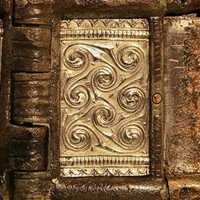The Moylough Belt Shrine
Christian Bronze Reliquary: History, Description,
La Tene Interlace Design.
![]()
|
The Moylough Belt Shrine |
 Detail from the Moylough Belt Shrine A masterpiece of Christian metalwork from the 8th Century CE. |
Moylough Belt Shrine (8th Century)The Moylough Belt Shrine, a reliquary from the era of early Christian art, ranks along with the Broighter Collar, the Petrie Crown, the Ardagh Chalice, the Derrynaflan Chalice and the Tara brooch as one of the great treasures of Irish goldsmithing in the National Museuem of Ireland. Discovered in a bog in 1945, the shrine exemplifies the art of Celtic metalwork from the 8th century CE, and is the only surviving example of a belt shrine in Ireland. It exemplifies the great golden age in the history of Irish art, which, in addition to masterpieces of metalcraft, gave us the immortal illuminated gospel manuscripts such as the Book of Durrow (c.670), the Lindisfarne Gospels (c.698-700) and the Book of Kells (c.800), as well as the famous High Cross sculptures - the most important body of free-standing sculpture between the fall of Rome and the Gothic Renaissance. |
| HISTORY
OF CELTIC CULTURE For details of the development of metalwork among the Ancient Celts, which culminated in the masterpieces of the late La Tene period and Hiberno-Saxon Insular style, please see: Celtic Art, Early Style Celtic Coins Art Celtic Art, Wadalgesheim Style Celtic Art, Late European Style Celtic Art in Britain and Ireland Celtic Style Christian Art |
|
DESIGNS OF THE ANCIENT
CELTS METALWORK OF THE
CELTS ECCLESIASTICAL
IRISH ART |
Discovery The Moylough Belt Shrine was discovered by a local man named John Towey, in County Sligo when cutting turf. It was found lying unwrapped about four feet below the surface. According to Dr Joseph Raftery, the museum's acting curator of antiquities at the time, the artifact was one of the finest objects acquired by the Antiquity Department over the previous 50 years, being a particularly fine specimen of early Christian metal, glass and enamel work of the Hiberno-Saxon Insular period. He purchased it on behalf of the museum for £100. Description The Moylough Belt Shrine is composed of a set of four hinged metal plates containing remains of a leather belt, enclosed in a bronze shrine. The Shrine is ornamented with silver, glass and enamel. The two front plates are arranged like a false buckle, while their frames are decorated with zoomorphic imagery - bird and animal heads - terminating in elaborate glass settings. They also display stamped silver foils emblazoned with spiral and interlace designs. Another motif, repeated several times is the Celtic cross. The hollow cavities in the artifact contain small lengths of leather - one reason why the piece is called a belt shrine. Early Christian Shrines Items connected with the lives of saints were often preserved during this period, and lodged in shrines or reliquaries. These containers were often crafted from precious metal (bronze, copper, silver) and suitably embellished to celebrate the importance of their relics. Mostly carried around the waist or hung by a strap around the neck, these shrines were used for a variety of rituals, including oath swearing, truth ceremonies or even to cure disease. Construction and Influences The style of the buckle is copied from Anglo-Saxon models of the Insular style, prevalent in England during the eighth century. The interlocking T and L-shaped elements of alternating yellow and red enamel, combined with plates of millefiori glass, sit alongside German-style stamped silver foils and spherical studs with inset silver grilles. Despite such English and Contintental influences, the patternwork of the Moylough Belt Shrine derives from La Tene interlace designs of late Iron Age Celtic Culture. The La Tene idiom (c.450-50 BCE) superceded the earlier Hallstatt culture of the Upper Danube (c.800-450 BCE), which was the first significant style of Celtic art. At present, the artifact is on display at the National Museum of Country Life, in County Mayo, before returning to the National Museum of Ireland in June 2009. Other outstanding religious artifacts from the era of early Christian art in Ireland, include the Tully Lough Cross (8th/9th century) found at the bottom of a lake in County Roscommon, and the superb 12th century Cross of Cong commissioned by King Turlough O'Connor. |
|
• For more about Irish cultural history
and craftwork, see: Visual Arts in Ireland. ENCYCLOPEDIA OF IRISH GOLDSMITHERY AND METALWORK |